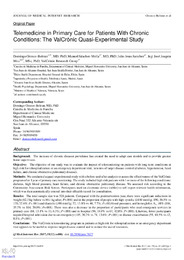Por favor, use este identificador para citar o enlazar este ítem:
https://hdl.handle.net/11000/37958Registro completo de metadatos
| Campo DC | Valor | Lengua/Idioma |
|---|---|---|
| dc.contributor.author | Orozco-Beltran, Domingo | - |
| dc.contributor.author | Sánchez-Molla, Manuel | - |
| dc.contributor.author | Sanchez, Julio Jesus | - |
| dc.contributor.author | Mira, José Joaquín | - |
| dc.contributor.other | Departamentos de la UMH::Medicina Clínica | es_ES |
| dc.contributor.other | Departamentos de la UMH::Psicología de la Salud | es_ES |
| dc.date.accessioned | 2025-11-07T10:29:59Z | - |
| dc.date.available | 2025-11-07T10:29:59Z | - |
| dc.date.created | 2017-07 | - |
| dc.identifier.citation | Journal of Medical Internet Research, 19(12), e400 - December 2017 | es_ES |
| dc.identifier.issn | 1438-8871 | - |
| dc.identifier.uri | https://hdl.handle.net/11000/37958 | - |
| dc.description.abstract | Background: The increase of chronic diseases prevalence has created the need to adapt care models and to provide greater home supervision. Objective: The objective of our study was to evaluate the impact of telemonitoring on patients with long-term conditions at high risk for rehospitalization or an emergency department visit, in terms of target disease control (diabetes, hypertension, heart failure, and chronic obstructive pulmonary disease). Methods: We conducted a quasi-experimental study with a before-and-after analysis to assess the effectiveness of the ValCrònic program after 1 year of primary care monitoring. The study included high-risk patients with 1 or more of the following conditions: diabetes, high blood pressure, heart failure, and chronic obstructive pulmonary disease. We assessed risk according to the Community Assessment Risk Screen. Participants used an electronic device (tablet) to self-report relevant health information, which was then automatically entered into their eHealth record for consultation. Results: The total sample size was 521 patients. Compared with the preintervention year, there were significant reductions in weight (82.3 kg before vs 80.1 kg after; P=.001) and in the proportion of people with high systolic (≥140 mmHg; 190, 36.5% vs 170, 32.6%; P=.001) and diastolic (≥90 mmHg; 72, 13.8% vs 40, 7.7%; P=.01) blood pressures, and hemoglobin A1c ≥8% (186, 35.7% vs 104, 20.0%; P=.001). There was also a decrease in the proportion of participants who used emergency services in primary care (68, 13.1% vs 33, 6.3%; P<.001) and in hospital (98, 18.8% vs 67, 12.8%; P<.001). Likewise, fewer participants required hospital admission due to an emergency (105, 20.2% vs 71, 13.6%; P<.001) or disease exacerbation (55, 10.5% vs 42, 8.1%; P<.001). Conclusions: The ValCrònic telemonitoring program in patients at high risk for rehospitalization or an emergency department visit appears to be useful to improve target disease control and to reduce the use of resources. | es_ES |
| dc.format | application/pdf | es_ES |
| dc.format.extent | 13 | es_ES |
| dc.language.iso | eng | es_ES |
| dc.publisher | JMIR Publications | es_ES |
| dc.rights | info:eu-repo/semantics/openAccess | es_ES |
| dc.rights | Attribution-NonCommercial-NoDerivatives 4.0 Internacional | * |
| dc.rights.uri | http://creativecommons.org/licenses/by-nc-nd/4.0/ | * |
| dc.subject | chronic disease | es_ES |
| dc.subject | primary health care | es_ES |
| dc.subject | telemedicine | es_ES |
| dc.subject.other | CDU::6 - Ciencias aplicadas::61 - Medicina | es_ES |
| dc.title | Telemedicine in Primary Care for Patients With Chronic Conditions: The ValCrònic Quasi-Experimental Study | es_ES |
| dc.type | info:eu-repo/semantics/article | es_ES |
| dc.relation.publisherversion | https://doi.org/10.2196/jmir.7677 | es_ES |

Ver/Abrir:
Telemedicine in Primary Care for Patients With Chronic Conditions The ValCrònic Quasi-Experimental Study.pdf
891,96 kB
Adobe PDF
Compartir:
 La licencia se describe como: Atribución-NonComercial-NoDerivada 4.0 Internacional.
La licencia se describe como: Atribución-NonComercial-NoDerivada 4.0 Internacional.
.png)